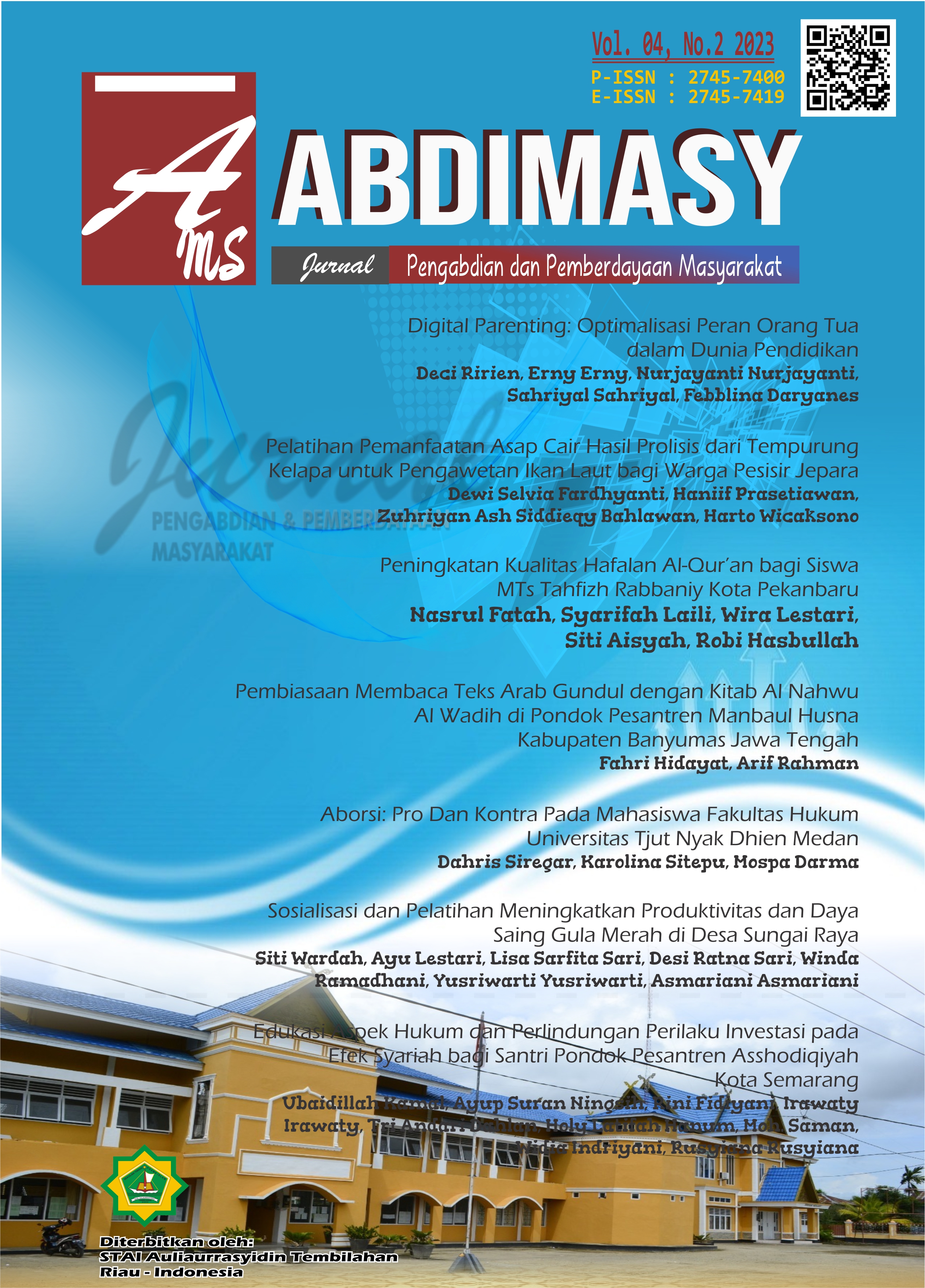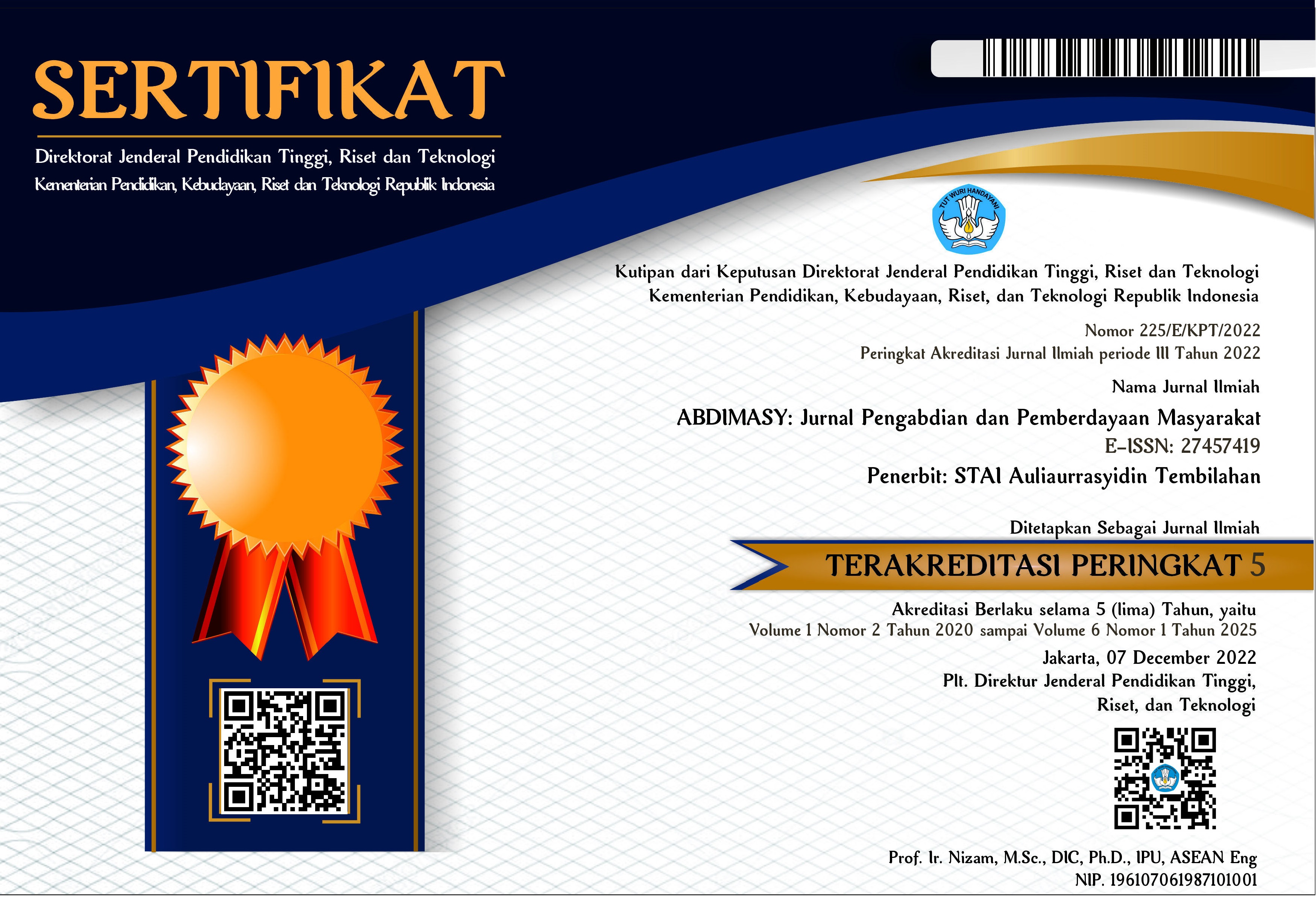Aborsi: Pro Dan Kontra Pada Mahasiswa Fakultas Hukum Universitas Tjut Nyak Dhien Medan
DOI:
https://doi.org/10.46963/ams.v4i2.1213Keywords:
Abortion, Student, Woman, PromiscuityAbstract
Abortion is a controversial topic in the legal context of many countries. It involves complex ethical and moral debates, as well as legal considerations involving women's reproductive rights and the life status of the fetus. The purpose of this service is to analyze the pro and con arguments in the legal debate about abortion, by considering the legal, ethical and social factors related to the law faculty student environment at Tjut Nyak Dhien University, Medan, North Sumatra. This service uses a descriptive-analytical approach, which involves text analysis. This approach allows identification and analysis of the arguments used by both those for and against the legalization of abortion. In the pro-abortion context, the main argument put forward is the protection of women's reproductive rights, including the right to control their own bodies and the right to pregnancy decisions. On the other hand, those who oppose the legalization of abortion put forward moral and ethical arguments, assuming that fetuses have the same status in life as adult humans. The aim of this service is to provide lessons on the pros and cons of abortion and understanding to students, especially law faculty students at Tjut Nyak Dhien University, in preventing promiscuity between fellow students and the importance of understanding sexual life in everyday interactions.
Downloads
References
Abdullah, R. A. R. (2021). Ethics and Legal Issues in the Abortion Case. Semarang State University Undergraduate Law and Society Review, 1(2), 175–190. https://doi.org/10.15294/lsr.v1i2.50547
Andrea Swartzendruber, D. N. L. (2020). Direktori Pusat Kehamilan Krisis (CPC) Berbasis Web di Amerika Serikat: Deskripsi Metode Peta CPC dan Fitur Desain serta Analisis Data Dasar. Surveilans Kesehatan Masyarakat JMIR., 6(1). https://doi.org/10.2196/16726
Chew, C. (2010). Jangan Gugurkan Aku ! : Kesaksian Tentang Pergumulan dan Pemulihan di Seputar Tindak Aborsi (N. Oktorino (ed.); Cetakan ke). Gunung Mulia.
Dewi, M. H. U. (1997). Aborsi : pro dan kontra di kalangan petugas kesehatan (Cet. 1.). Universitas Gadjah Mada. Pusat Penelitian dan Studi Kependudukan.
Glanz, K. (2015). Health Behavior: Theory, Research, and Practice (Jossey-Bass Public Health) (5th ed.). Jossey-Bass.
Langie, Y. N. (2014). Tinjauan yuridis atas aborsi di indonesia (studi kasus di kota manado). J Lex Et Societatis, 2(2), 51–61.
Qaisar, A. (2009). Pro Life and Pro Choice Debate: A Journey From Restriction To Regulation – Destination Pakistan. Pakistan Law Journal, November, 25–37.
Rukmahanadi, H. (2012). Tinjauan Terhadap Aborsi Dari Aspek Hukum Kesehatan Dan Perlindungan Anak. 42.
Sherlly. (2020). Aborsi dalam Pandangan Hukum dan Masyarakat. Jurnal Fakultas Hukum UBB, 1(1), 1–5.
Wijayati, M. (2017). Aborsi Akibat Kehamilan Yang Tak Diinginkan (KTD): Kontestasi Antara Pro-Live dan Pro-Choice. Analisis: Jurnal Studi Keislaman, 15(1), 43–62. https://doi.org/10.24042/ajsk.v15i1.712
Zaenurrosyid, A. (2017). Bioetika Islam: Tindakan Aborsi dalam Konteks Keindonesiaan. Jurnal Tribakti, 20(1), 1–17.
Downloads
Published
Issue
Section
License
Copyright (c) 2023 Dahris Siregar, Karolina Sitepu, Mospa Darma

This work is licensed under a Creative Commons Attribution-ShareAlike 4.0 International License.
Authors who publish with this journal agree to the following terms:
1. Copyright on any article is retained by the author(s).
2. The author grants the journal, right of first publication with the work simultaneously licensed under a Creative Commons Attribution shareAlike 4.0 International License that allows others to share the work with an acknowledgment of the work’s authorship and initial publication in this journal.
3. Authors are able to enter into separate, additional contractual arrangements for the non-exclusive distribution of the journal’s published version of the work (e.g., post it to an institutional repository or publish it in a book), with an acknowledgment of its initial publication in this journal.
4. Authors are permitted and encouraged to post their work online (e.g., in institutional repositories or on their website) prior to and during the submission process, as it can lead to productive exchanges, as well as earlier and greater citation of published work.
5. The article and any associated published material is distributed under the Creative Commons Attribution-ShareAlike 4.0 International License





2.png)



